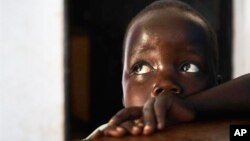Two rights groups say violence affects about one billion children every year and its consequences cost economies $7 trillion annually. The NGOs say while violence against women and girls has gained more attention, violence against boys has not. It’s a leading cause of death for adolescent boys in many parts of the world.
The groups Without Violence and Together for Girls say violence against children is a major challenge to development. They say that “continued exposure to violence – whether as a victim or a witness – has significant detrimental effects on a child’s brain.” Those effects include post-traumatic stress leading to social, emotional and behavioral problems.
Lisa Witter is executive director of Without Violence or as she describes herself, the group’s “chief optimist.”
“Violence against children is an issue that happens all around the world – in every country, in every income level of the home and whether the parents are educated or not," she said. "And violence against children happens everywhere. We’ve learned in talking about the issue of violence that different people have definitions about what violence against children is. Is it mental abuse? Is it physical abuse? Is it corporal punishment? Is it war? It’s all of it. We’re really looking at reducing violence in any setting and in any way against children.”
Witter said girls are especially vulnerable to sexual violence and child marriage, which she also considers a form of violence.
“Girls are much more likely to be married under the age of 18 than boys. And this is a real violent act," she said. "It’s not under her own will and they should be girls, not brides.”
As for boys, she said, “One in five victims of homicide are children and boys account for 70 percent of them. Real, harsh violence is really a big issue for boys. Sexual violence, as I said, is a big issue for girls, but 73 million boys under the age of 18 experience sexual violence. So while girls are at a higher risk factor for it, it’s a boys’ issue. And then the other issue we think a lot about are child soldiers. There are an estimated 250,000 child soldiers in the world and 90 percent of them are boys.”
She also said that 156 million men alive today were married as children.
Witter and Michele Moloney-Kitts, head of Together for Girls, have written an opinion piece in which they said, “Violence is like a transmitted disease – and growing up around violence is the single best predictor that a child will go on to become either a victim or perpetrator of violence as adults.”
They said that gender norms make it difficult for boys to admit they are victims of violence. In fact, on average, men who finally disclose they were sexually assaulted do so 22 years after the assault occurred. That’s about 10 years later than women.
To help boys become less vulnerable to violence, the NGOs recommended parenting programs for caregivers. School-based programs, they say, can teach adolescents about “safe dating practices.” Mentoring programs have shown success in preventing homicides or joining gangs.
The groups want the issue included in the new U.N. Sustainable Development goals that will be finalized in September. Witter said life can be better for every child if U.N. members invest in breaking the cycle of violence.
“I care deeply about boys and girls, you know. And I want to reduce violence against girls and I want to reduce violence against boys," she said. "I’m a mother of two young boys, six and eight, and this stuff is very personal to me. We can’t stop the cycle of violence unless we focus on boys and girls. What we want to do is just continue through the U.N. process and through talking to companies and through talking to communities and help scaling things that we know that work so that we reduce violence.”
In related news, at the Third International Conference for Financing for Development in Addis Ababa this week, a global partnership was announced to end violence against children.












